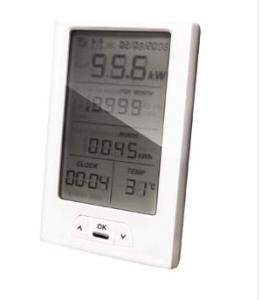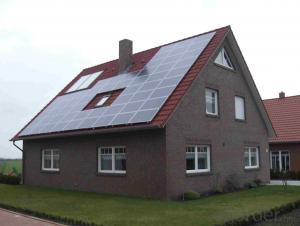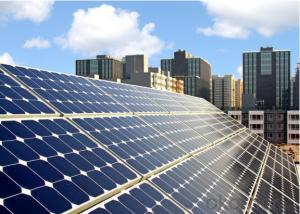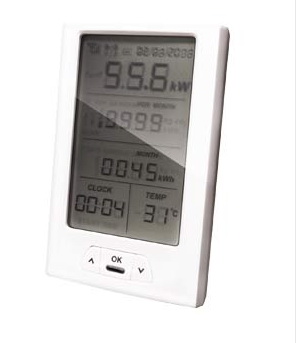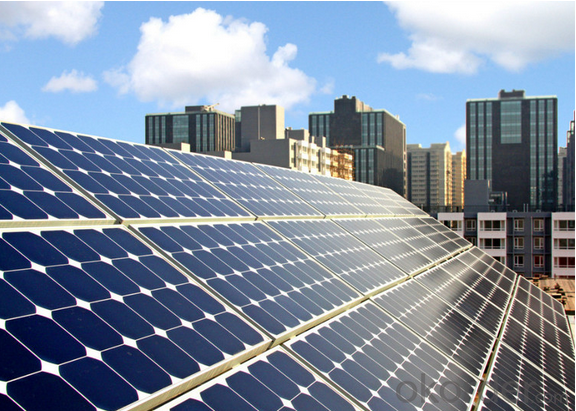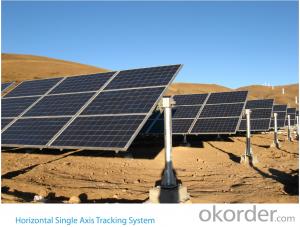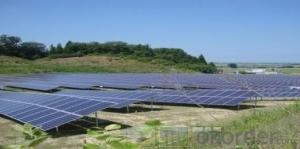Solar System Monitor Shine Vision, Monitoring System
- Loading Port:
- Shekou
- Payment Terms:
- TT OR LC
- Min Order Qty:
- 50 watt
- Supply Capability:
- 10000 watt/month
OKorder Service Pledge
OKorder Financial Service
You Might Also Like
Solar System Monitor Shine Vision, Monitoring System
Specifications
>monitor the inverters
>Browse data
>Communicate with inverters by RS485 or RS232
>Monitor capacity: 8 inverters via RS485
> RF communication for wireless operation
> Automatic monitoring of up to six inverters simultaneously, applicable for small home system.
> Simple installation. It can be placed anywhere indoor with signal coverage.
> Easy-to-understand data display by simple key operation: real-time power, three-phase AC voltage, PV voltage, daily, monthly and total power yield and income, temperature, light intensity, the date and time.
> Data archiving automatically and permanently with high security
> Audio alarm in the event of errors
> Low power consumption, powered by adaptor or battery.
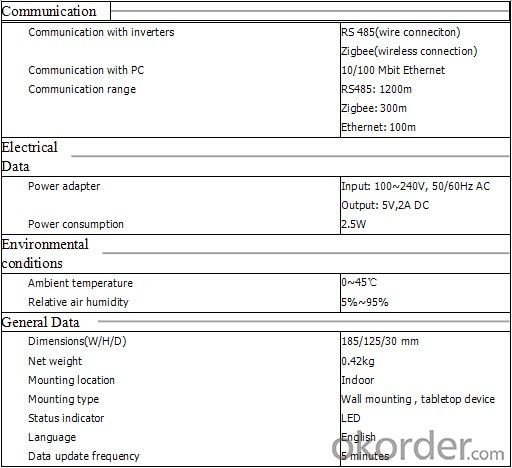
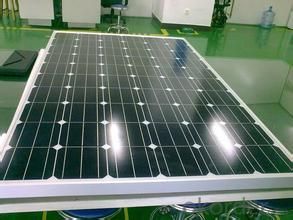
FAQ
1. Have any design tool and how to use it?
Shine Design is the system design software just for inverters, It can conduct installers to figure out panel numbers for a system, panel numbers for each string, and which inverter model is suitable for the system. Moreover, it can print a design report after input all necessary parameters, can calculate DC/AC wire wastage, annual generation, etc.
2. Does the inverter have monitoring solutions for residential system?
For small rating system, we have wired two monitoring solution (ShineNet via RS232 or RS485). (a) Local wireless monitoring solution (ShineVision via RF module communication) (b) Global wireless monitoring solution (WIFI module via WIFI network)
3. Do you have free solution for monitoring?
ShineNet is an inverter monitoring software run in Windows XP, Windows Vista, Windows 7 operating system. It can monitor inverter via RS232 (or RS232 convert to USB cable) and RS485 wire connection. Customers can purchase the cable locally to get the inverter monitored, it is simple.
- Q: Can a solar inverter be used with a solar-powered irrigation system?
- Yes, a solar inverter can be used with a solar-powered irrigation system. The solar inverter is responsible for converting the direct current (DC) generated by the solar panels into alternating current (AC) that can be used to power the irrigation system. This allows the solar energy to be efficiently utilized for irrigation purposes.
- Q: What is the role of a solar inverter in voltage support?
- The role of a solar inverter in voltage support is to convert the direct current (DC) produced by solar panels into alternating current (AC) that can be used by the electrical grid. Additionally, it helps regulate and stabilize the voltage levels, ensuring that the electricity generated from solar power is compatible with the grid's voltage requirements.
- Q: Can a solar inverter be used in commercial or industrial applications?
- Yes, a solar inverter can be used in commercial or industrial applications. In fact, they are commonly utilized in these settings to convert the direct current (DC) generated by solar panels into alternating current (AC) that can power various electrical equipment and systems. Solar inverters enable efficient and reliable integration of solar energy into commercial and industrial operations, contributing to cost savings and environmental sustainability.
- Q: How does a solar inverter handle voltage harmonics?
- A solar inverter handles voltage harmonics by using filters and control algorithms to reduce or eliminate the distortion caused by harmonics in the power generated by the solar panels. These filters and algorithms help to ensure that the electricity produced by the solar panels is of high quality and compliant with the desired voltage standards.
- Q: Can a solar inverter be integrated with a smart home system?
- Yes, a solar inverter can be integrated with a smart home system. Many modern solar inverters have built-in communication capabilities, such as Wi-Fi or Ethernet, which allow them to connect to a smart home system. This integration enables homeowners to monitor and control their solar power production and energy consumption conveniently through a centralized smart home platform. They can track energy production, set energy usage preferences, and even automate certain functions based on available solar power.
- Q: Can a solar inverter work during a power outage?
- No, a solar inverter cannot work during a power outage unless it is specifically designed with a backup power supply or battery storage system.
- Q: What is the role of a solar inverter in optimizing energy production?
- The role of a solar inverter in optimizing energy production is to convert the direct current (DC) electricity generated by the solar panels into alternating current (AC) electricity that can be used to power homes and businesses. It also helps in managing and controlling the flow of electricity from the solar panels to the grid or batteries, ensuring maximum efficiency and utilization of the generated energy. Additionally, solar inverters monitor the performance of the solar system, providing vital data and feedback to optimize energy production and identify any issues or maintenance requirements.
- Q: Can a solar inverter be used with solar-powered water purification systems?
- Yes, a solar inverter can be used with solar-powered water purification systems. A solar inverter is responsible for converting the direct current (DC) power generated by solar panels into the alternating current (AC) power required for most electrical devices. Since water purification systems often require AC power to operate, integrating a solar inverter allows the system to utilize the energy harnessed from solar panels efficiently.
- Q: How does a solar inverter affect the overall efficiency of a solar system?
- A solar inverter plays a crucial role in the overall efficiency of a solar system. It converts the direct current (DC) generated by solar panels into alternating current (AC) that can be used to power household or commercial appliances. By ensuring optimal conversion efficiency and minimizing power losses during this process, a high-quality solar inverter can significantly impact the overall efficiency of a solar system.
- Q: How does the quality of the AC waveform affect the performance of a solar inverter?
- The quality of the AC waveform directly impacts the performance of a solar inverter. A poor quality waveform can introduce harmonics and distortions, leading to reduced efficiency, increased heat generation, and decreased overall performance of the inverter. It can also cause issues with the functioning of other electrical equipment connected to the inverter. Therefore, ensuring a high-quality and clean AC waveform is crucial for optimal performance and longevity of a solar inverter.
Send your message to us
Solar System Monitor Shine Vision, Monitoring System
- Loading Port:
- Shekou
- Payment Terms:
- TT OR LC
- Min Order Qty:
- 50 watt
- Supply Capability:
- 10000 watt/month
OKorder Service Pledge
OKorder Financial Service
Similar products
Hot products
Hot Searches
Related keywords
